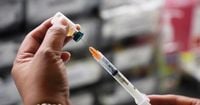The Centers for Disease Control and Prevention’s (CDC) vaccine advisory panel, the Advisory Committee on Immunization Practices (ACIP), found itself at the heart of a heated national debate this week as it weighed major changes to childhood vaccine recommendations. The two-day meeting, which began on September 18, 2025, placed the committee under an intense spotlight, with implications that could ripple through the nation’s public health policy, parental choice, and trust in scientific guidance.
The meeting came amid a period of extraordinary upheaval for the CDC and its advisory structures. In the months leading up to the session, Health and Human Services (HHS) Secretary Robert F. Kennedy Jr. had replaced 17 ACIP members with his own appointees, some of whom have histories as vaccine skeptics. According to reporting by CBS News, this shake-up marked a sharp departure from the usual process, where agency officials would vet potential experts before sending them to the secretary for approval.
The controversy deepened when Dr. Susan Monarez, who served as CDC director for just 29 days, testified before Congress on September 17, 2025. Monarez alleged she was ousted after refusing to approve changes to vaccine recommendations without scientific evidence. "He just wanted blanket approval. And if I could not commit to approval of each and every one of the recommendations that would be forthcoming, I needed to resign," Monarez told lawmakers, referring to Kennedy. She added, "I did not resign, and that is when he told me he had already spoken to the White House about having me removed." Monarez said she is "very nervous" about the upcoming childhood vaccine panel recommendations, expressing concern that the current committee may lack the necessary expertise to evaluate the evidence appropriately.
The ACIP’s agenda included two particularly contentious issues: the timing of the hepatitis B vaccine for newborns and the use of the combined measles, mumps, rubella, and varicella (MMRV) vaccine for young children. For over three decades, CDC policy has recommended administering the hepatitis B vaccine within 24 hours of birth, a move credited by Senator Bill Cassidy, a hepatologist, with reducing newborn hepatitis B infections by 68% in the decade following its introduction. "Before 1991, as many as 20,000 babies were infected with hepatitis B in the United States of America," Cassidy recalled during a Senate hearing. "That changed when the hepatitis B vaccine was approved for newborns." Today, fewer than 20 babies contract the disease from their mothers each year, a dramatic drop attributed to the universal birth dose.
Yet, the ACIP considered a proposal to delay the first hepatitis B vaccine dose until at least one month of age for infants born to mothers who test negative for the virus (HBsAG-negative), with shared clinical decision-making for earlier doses. The rationale for revisiting this well-established policy was debated vigorously. Dr. Robert W. Malone, an ACIP member, noted, "It's clear that a significant population of the United States has significant concerns about vaccine policy and about vaccine mandates. There has been a significant decrease in public support for vaccination... and the hepatitis B birth dose has been a focus of folks that have these types of concerns." However, several medical organization representatives, including Dr. Flor M. Muñoz of the National Foundation for Infectious Diseases, questioned the need for change, asking, "Why are we addressing this hepatitis B vaccine recommendation? Is there really a reason that the committee can provide for making a change?"
CDC presenter Dr. Adam Langer cautioned against delaying the birth dose, warning that infants could be exposed to hepatitis B from household contacts, daycare, or visitors—especially since about half of those with hepatitis B are unaware of their infection. He emphasized, "There is no evidence that the risk of already rare adverse events is any greater among newborns than among older infants." The most serious side effect, anaphylaxis, has been reported at a rate of only 1.1 cases per million vaccine doses administered. Langer concluded that the only potential benefit of rescinding the current recommendation would be a marginal reduction in rare adverse events, which are typically mild.
The ACIP also tackled the use of the combined MMRV vaccine in young children. On September 18, the committee voted 8 to 3, with one abstention, to change its recommendation: "For measles, mumps, rubella and varicella vaccines given before age 4 years, the combined MMRV vaccine is not recommended." Instead, children under 4 should receive separate MMR and varicella vaccines. This move was prompted by data showing that the combined shot carries a slightly higher risk of febrile seizures—brief, fever-related seizures that, while frightening, almost always resolve without lasting effects—when administered as the first dose in toddlers between 12 and 23 months of age. Dr. Cody Meissner, a former FDA vaccines panel member, maintained, "the vaccine is safe with no evidence of harm." But others, like Vicky Pebsworth of the National Association of Catholic Nurses, voiced concerns about gaps in the safety data for very young infants.
Coverage and access implications were also debated. The Vaccines for Children (VFC) program, which supports immunizations for Medicaid, uninsured, and underinsured children, will continue to cover both the combined MMRV and separate MMR+V vaccines for those under age 4. However, Dr. Joseph Hibbeln, an ACIP member, warned, "the parents' choice is taken away" unless they pay out of pocket for the combined shot, potentially limiting access for families who prefer fewer injections or have difficulty accessing care.
The committee’s deliberations unfolded against a backdrop of broader political and regional divides. Four Democratic-led states—California, Oregon, Hawaii, and Washington—formed the West Coast Health Alliance, issuing their own guidance that aligns with mainstream medical organizations and recommends staying up to date on COVID-19, flu, and RSV vaccines for the 2025-26 respiratory virus season. Their joint statement declared, "Our states are united in putting science, safety, and transparency first—and in protecting families with clear, credible vaccine guidance." The Alliance’s recommendations focus on protecting those most at risk: infants, older adults, pregnant women, and people in close quarters.
Not everyone agreed with these state-level moves. HHS spokesperson Andrew Nixon criticized the West Coast Alliance’s guidance, stating, "Democrat-run states that pushed unscientific school lockdowns, toddler mask mandates and draconian vaccine passports during the COVID era completely eroded the American people’s trust in public health agencies. HHS will ensure policy is based on rigorous evidence and Gold Standard Science, not the failed politics of the pandemic."
Meanwhile, health insurers reaffirmed that they will continue to cover all vaccines recommended by the ACIP as of September 1, 2025, including the latest COVID-19 and influenza formulations, with no out-of-pocket costs through 2026. This assurance comes as the CDC’s vaccine guidance wades through an unusually public and politicized process, with the ultimate decisions expected to shape both access and confidence in immunization programs for years to come.
As the ACIP prepares to vote on the hepatitis B and COVID-19 vaccine recommendations, the stakes have rarely been higher. The committee’s choices—made under the glare of political scrutiny and public skepticism—will not only determine technical details of vaccine schedules but may also set the tone for the nation’s approach to science, trust, and public health in a new era.

